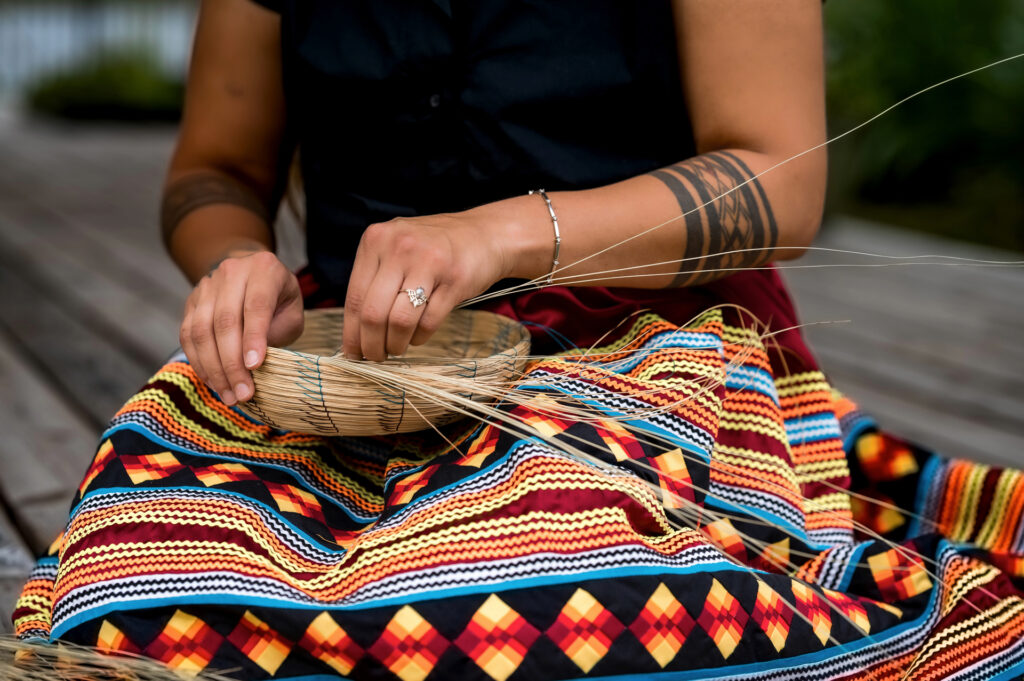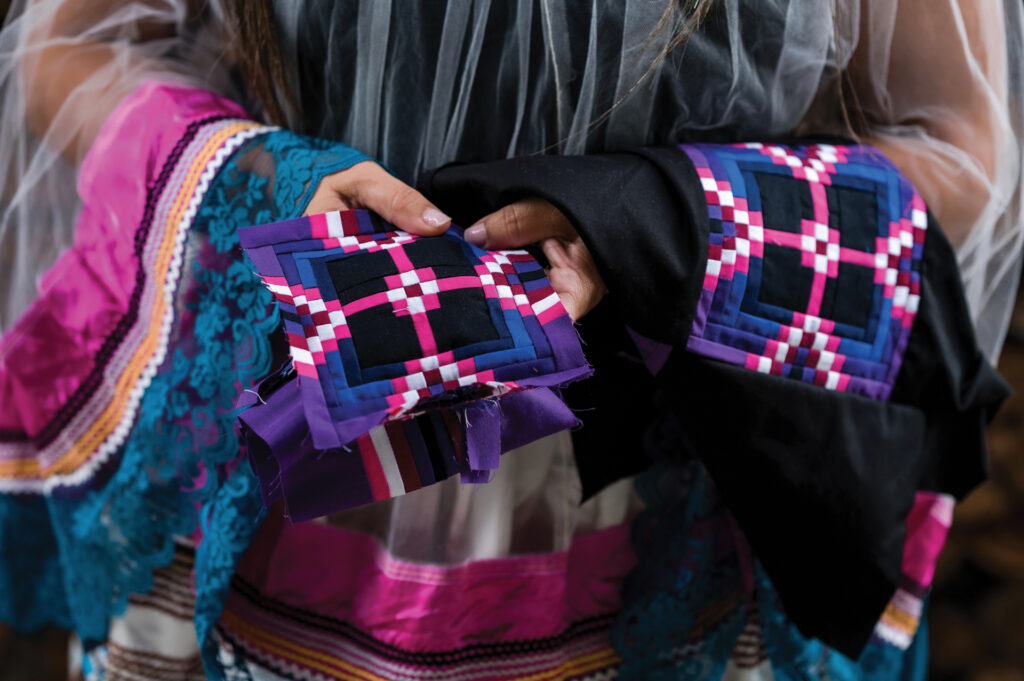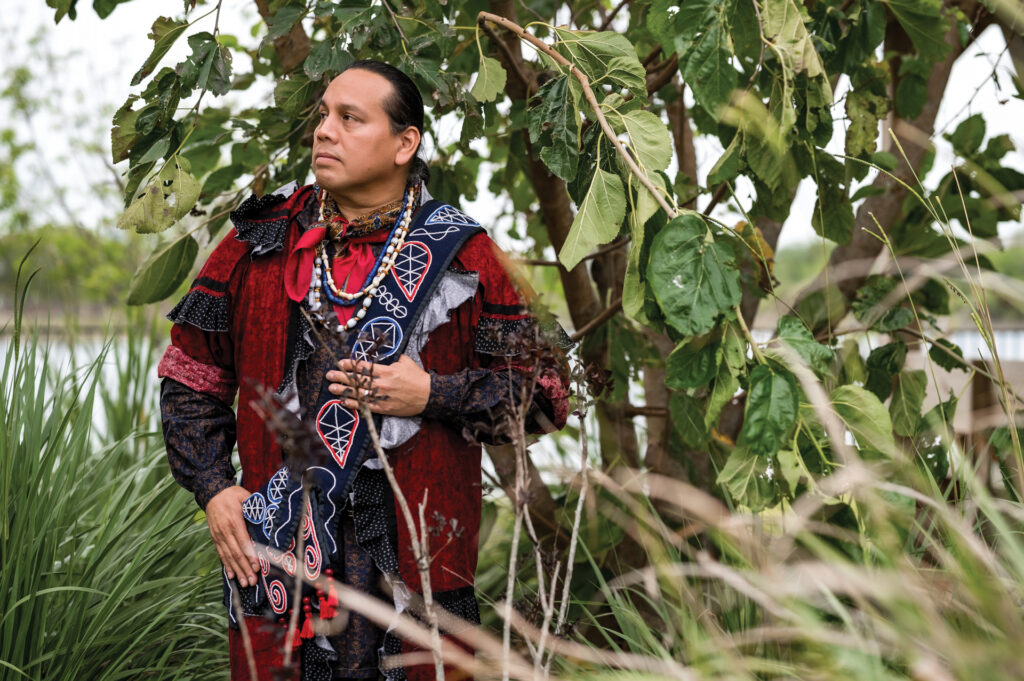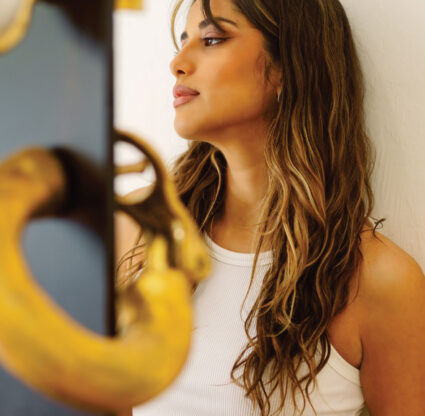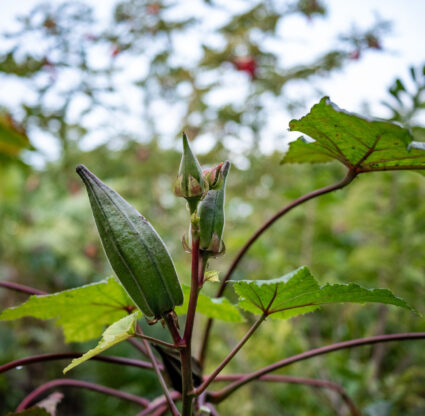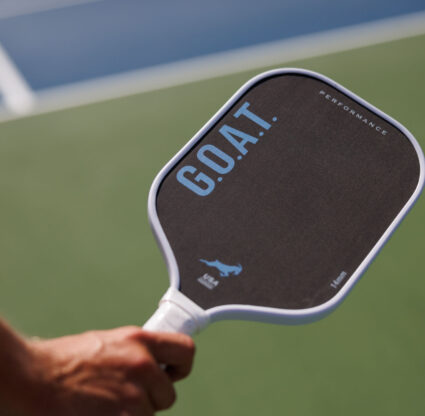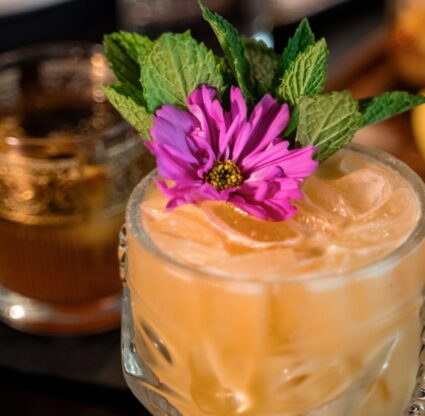It’s early morning as the Osceola-Zepeda crew caravans along I-75 to Hollywood, where Florida’s Seminole Tribe hosts an annual powwow and fair. There, they’ll connect with fellow parents and children dressed in colorful patchwork garments, reveling in their storied culture and customs. These are the true Floridians: people who lived on the land long before Barron G. Collier brought Tamiami Trail through the region or established the county in 1923. They worked with nature to thrive as a community of artists, hunters, gatherers and storytellers.
Sisters Marissa, Jessica and Karie Osceola and their cousins—who they consider brothers—Pedro and Brian Zepeda are proud, prominent members of Florida’s largest Indigenous tribe, the Seminole. You may recognize the Osceola name—perhaps from their grandfather-figure (their great-uncle) legendary chickee hut maker O.B. Sr. Their great-grandmother, Juanita, is the namesake for Naples’ Juanita Osceola Center, a hub for Seminole culture and education. The younger Osceolas fully embrace their ancestors’ artisanal traditions and dedicate much of their professional and personal lives to preserving them. Jessica, the middle of three sisters, smiles when she reflects on artistic Seminole practices: “It’s a community process and individual sport all in one.”
The Osceola-Zepeda siblings fondly recall growing up in Collier County in the ’80s and ’90s. While they relish memories of their family’s involvement in the community, the region’s rapid growth has overshadowed much of the Indigenous culture’s presence. “The amount of development led to a lack of planning,” Pedro laments. Karie chimes in: “Most individuals I come across are surprised to learn that native people are still present in Collier County. The average citizen needs to be made aware that tribal people still exist and are thriving.”
The elder siblings grew up in the area, learning from their seamstress grandmother Tahama Osceola and watching their elders sew, weave and carve in open-air chickee huts at the now-gone Seminole village on Tamiami Trail and inside the Juanita Osceola Center. (Marissa, the youngest by about a decade, credits her grandmother Susie Jimmie, who made all of Marissa’s childhood clothing—for inspiring her to sew.) Now, as parents, they ardently pass the traditions to their children. “Our culture is made of many little pieces, and we all do our part to carry on what we can and pass that on to the next generations,” Marissa says. Here, we trace each sibling’s craft and how they work to keep their traditions current and appreciated.
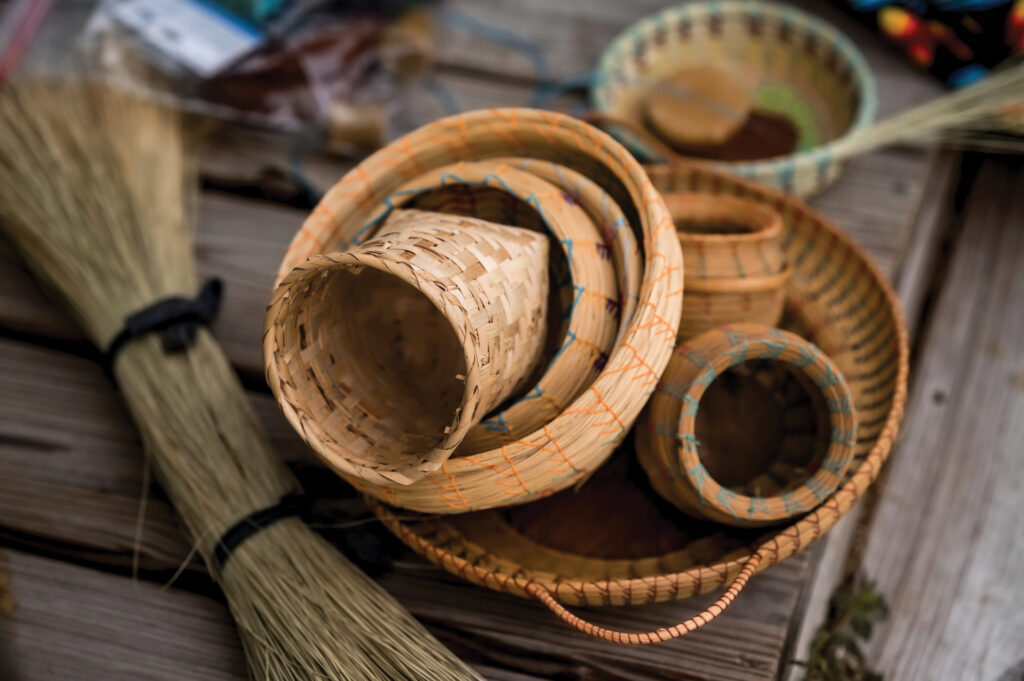
The Weaver: Marissa Osceola
Marissa, the youngest of the group, tackles many of her culture’s crafts, passing on lessons she gleaned from big sisters and her grandmother, Susie Jimmie. She’s already teaching her 3- and 6-year-old children to bead Seminole necklaces. Sitting around the kitchen table, little hands pick from bowls of leftover “bead soup” to string various colors into single-strand friendship necklaces to gift to their “Granny” or friends. “It keeps them busy,” she says with a laugh. Her daughter started beading when she was 2-years-old, while Marissa worked through online college courses. “If you have a craft, you make it for your family because those things are so treasured.”
Marissa recently returned to Naples after living in North Carolina and New Mexico. Back home, you might find her beading, sewing or weaving sweetgrass baskets—a nearly lost art form. Palmetto fibers provide a sturdy base for the baskets, made mainly from strands of native sweetgrass, also known as muhly grass. The fibrous material is coiled and woven to create beautiful vessels, now mostly limited to decorative pieces. Marissa learned to weave from her sister, Jessica, who used to teach classes at the Juanita Osceola Center. Now, other tribe members offer basket-weaving kits and lessons to help keep the art alive.
More recently, Marissa has started to focus on Seminole patchwork textiles (she’s perfecting her grandma Susie’s signature diamond patchwork in her honor) which, to her, epitomize the craftsmanship shared when a tightly-knit community of women comes together: “My first patchwork was made at my sister Karie’s kitchen table when I was a kid.”
The Seamstress: Karie Osceola
Marissa and Jessica describe Karie as their “sewing mentor,” but the eldest sister demurs—probably because she learned textile arts at a later age than her siblings. “As I grew older and started my own family, I gained much more interest in cultural arts and crafts,” Karie says. “After having kids, I figured it was best for me to learn sewing to provide traditional clothing for my family.” While she’ll sometimes sell her patchwork skirts and jackets at farmers markets and Indigenous fairs, most of Karie’s pieces are made for her family. In recent years, she’s enlisted her teen daughter, Angelina Osceola-Lugo, to help. They were both proud to see one of her first skirts sell quickly at a fair.
Traditionally, Karie explains, patchwork is designed to tell stories, with each patterned strip of fabric or colorful ric-rac hem representing an aspect of the narrative. You may find blue vertical stripes to dictate rain or zig-zagged lines in black, red and white to signify lightning. Other shapes resemble a man on a horse or the pattern of a rattlesnake’s scales. The order in which the pieces are sewn, she says, reflects the story’s timeline. Karie recently converted a garage to a home studio, where walls of shelves stock various swatches of fabric, ric-rac and thread in vibrant hues. A mannequin anchors the space, donning recent creations to spark inspiration for her next pieces. Many of the garments she makes for her family feature bright red fabrics, to honor their grandmother Tahama’s favorite shade.
The artful patchwork makes up much of the Seminole’s vibrant garments, taking the form of long, loose-fitting jackets and voluminous skirts. Strips of cotton fabric—which the Seminole once acquired from trading posts—are stitched together to create intricate geometric patterns and shapes. Pieces are then sewn into wide swatches to compose the jacket or skirt’s entire textile. “I knew that my grandmas and aunts were not going to be able to sew forever,” Karie says wistfully. “And I believe the shift of responsibility was mine to take on.”
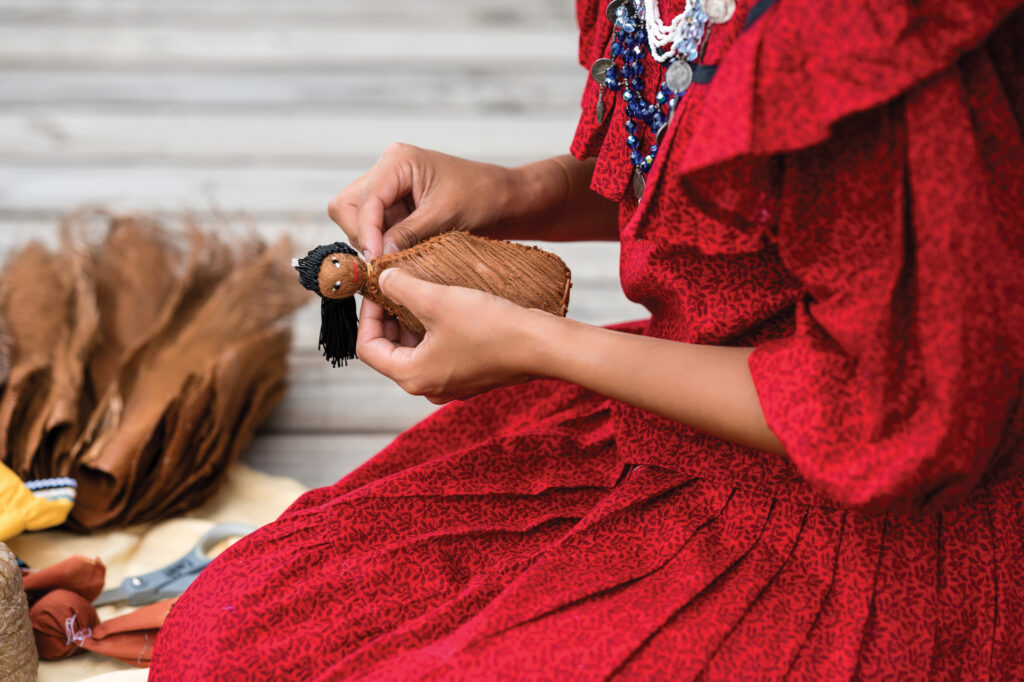
The Artist: Jessica Osceola
Jessica, the middle child of three girls, picked up on more than a few of her family’s artistic customs. She’s a prolific sewer—her textiles were on view during the latest art department staff exhibition at Florida Gulf Coast University (FGCU). The colorful works also filled the Marco Island Historical Museum in an aptly titled 2021 solo exhibition, Creating Home. And, a graduate of San Francisco’s Academy of Art University, Jessica is uniquely skilled with clay and teaches ceramics at FGCU. She’s known for her self-portraits, done in bas-relief sculpture, working with a shallow panel of clay to chisel prominent cheekbones and detailed layers of Seminole beads.
Regardless of the medium, her work is no stranger to museums. Sarasota’s The John and Mable Ringling Museum of Art recently acquired three of her ceramic portraits, which explore her mixed-race heritage (her Midwestern mother is Irish), for their collection. And, together with canoe-carver Pedro and multihyphenate Brian, Jessica is exhibiting in the Ringling’s seminal group exhibition Reclaiming Home: Contemporary Seminole Art. On view until early September, it’s the museum’s first show highlighting artwork created by Indigenous artists.
Working out of the micro-farm homestead she shares with her husband and their two kids, Jessica takes photos of her face and body, which she uses to create the bas-relief sculptures that emphasize emotion. In the pieces, she reflects on her heritage, her feelings as a mother, the legacy she’s leaving for her children and the world, and the importance of keeping her Seminole family’s traditions alive. “There’s a sense of identity and legacy in the importance of carrying on to my children,” she says.
The Storyteller: Brian Zepeda
Brian lives and breathes his Seminole heritage. One can often find him donning handmade garments during authentic reenactments of Seminole history, including the annual Dade Battlefield Historic State Park—the site for the largest American-Indian war—gathering in January. He’s a respected storyteller and educator, often teaching Seminole arts and crafts as a guest lecturer at universities and museums throughout the state. Far from stuffy, watching Brian lecture is more like a conversation with a friend. He weaves a mix of Seminole legend with modern advocacy to put his heritage at the forefront. At the 2022 Florida Folk Festival in White Springs, Brian spoke about the importance of clean water in Seminoles’ lives and how to work with legislators to ensure they have access to such. He’s a frequent speaker at the 71-year-old event.
He’s also a skilled craftsman: building canoes, silversmithing and constructing chickee huts. One day, he might be trekking through the Everglades, camera in tow; the next, he’s carefully beading a panel belt for his traditional outfits. “I take my role as a teacher and student of my culture very seriously,” Brian, the eldest of the group, says. “My grandpa used to tell me, ‘If someone takes the time to teach you something, then you need to take the time to learn.’”
He’s one of about six Indigenous artists in the U.S. who makes beaded bandolier, or shoulder, bags. The tactical wool bags were used to carry supplies, often for sharpening knives or building fires. The entire piece, including the straps, is encrusted with thousands of minuscule seed beads, which Brian painstakingly embroiders into custom designs. The beads–which the Seminole acquired through trade with settlers–are so small that one can hover around the size of a single letter on a penny. “It can take anywhere from four months to two years to complete one [bag],” he says. His intricate bandoliers, alongside his belts and photography, take center stage at the Ringling exhibition. His daughter, Corrine Zepeda, is also showing at the Ringling. Her graphic illustration of a Seminole man (strongly resembling her father) in signature Osceola red garb navigating a traditional dugout canoe is on full display spanning a wall at the exhibit’s entrance.
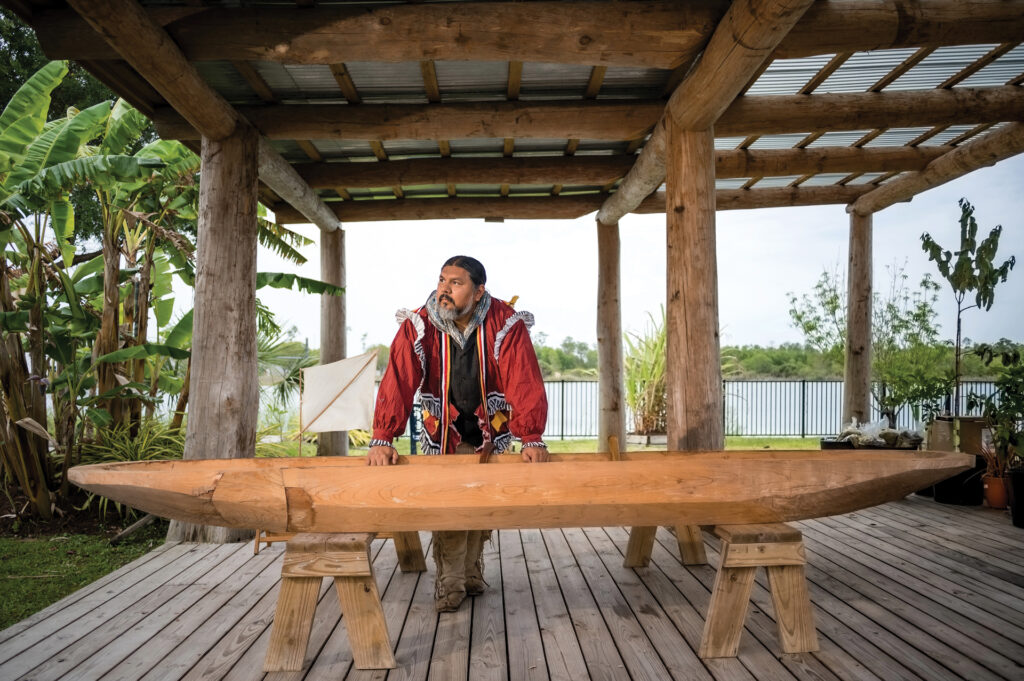
The Builder: Pedro Zepeda
Much like his siblings, Pedro is keen on preserving Seminole crafts. After studying ceramics at Stetson University, Pedro returned to Southwest Florida to take over as the Seminole Tribe’s traditional arts and outreach coordinator at the Ah-Tah-Thi-Ki Museum in Big Cypress Seminole Reservation. Leading the programs from 2007-2013, Pedro honed curricula and taught traditional Seminole arts to the public and fellow tribe members. In the role, he mastered a panoply of crafts, including fashioning bows, arrows and leather goods using the same materials and methods from generations before. He credits Brian, along with other tribe members, for teaching him his most prized art form: dugout canoe building.
The canoes are integral to the Seminole lifestyle. Carved by hand, the vessels are driven using a long pole to change pace or direction throughout the swamps. Pedro says locating an ideal log (preferably cypress) is the first and most daunting step. He avoids felling new-growth trees, and instead searches for sinker cypress, dropped in rivers as they were on their way to sawmills more than a century ago. “My grandparents would just use a standing cypress, but at that time, there were many more cypress trees than there are now,” he says. Once he’s found the perfect log, he’ll use chainsaws and axes to shape the canoe’s exterior shell and carve the dugout recess inside. Then, Pedro uses traditional carving tools, including adzes, scorps and inshaves, to refine the canoe by hand. The whole process can span weeks. “When we make these items, they’re not just objects. They contain knowledge,” Pedro says. “So if you lose the object, you’re also losing all the cultural knowledge that comes along with it, like stories, cultural etiquette, language.”

